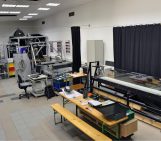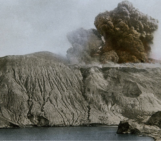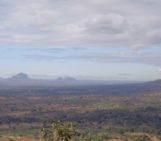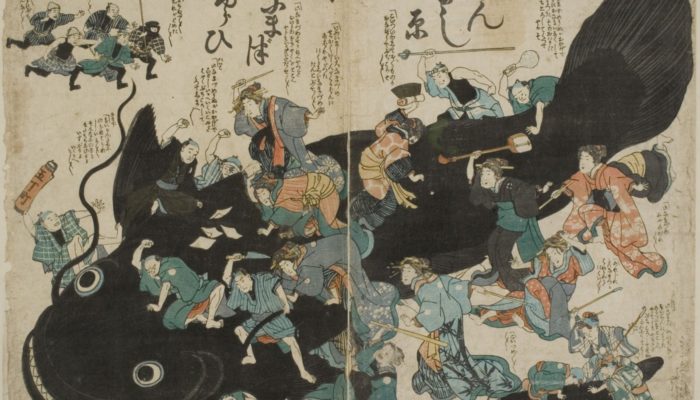
Welcome to this first post on the EGU TS blog’s newest series on Geomythology. Plate tectonic theory has existed for just over half a century but the Earth beneath us has always been active. In this series we explore historical and mythological explanations to tectonic phenomena we now understand, such as earthquakes, volcanoes, mountains, and others.
Japanese earthquakes
Japan is one of the countries with the highest frequency of localised earthquakes in the world (USGS Natural hazards FAQ). The island is located along the Pacific Ring of Fire, an extended area of subduction zones which cause volcanoes and ~90% of the worldwide earthquakes (Fig. 1a). The island of Japan is a volcanic arc, formed in response of a complex setting of four subduction zones (Fig.1b), between the Pacific, the Philippine, the North America, and the Eurasian tectonic plates, although the boundary between the Eurasian and the North American Plate in this area is still debated. The activity of these sinking plates generates recurrent volcanic eruptions and strong earthquakes, which in turn can cause tsunamis.

Fig. 1. (a) Simplified scheme of the tectonic plates setting around the Pacific Ring of Fire (red area). Base map from GeoMapApp (Ryan et al., 2009). (b) zoom on Japan seismicity from the USGS earthquake catalog.
This scientific explanation of recurring earthquakes is quite modern. In the period between 1600 and 1868, when a series of strong earthquakes struck Japan (Edo Period, NDLGEJEA Earthquake chronological table), the people did not know anything about subduction zones or tectonic plates, they believed it was the misbehaviour of Namazu instead.
Namazu the giant catfish
Namazu is the giant catfish of Japanese mythology, who lives and swims in the underground muddy and dense waters below Japan. Namazu is a cheeky catfish, who likes to cause trouble, and each time he moves his tail, he causes earthquakes. To stop Namazu from moving, Kashima, the god of thunder and war, is said to have dug deep down into the earth to weigh him down with a special stone, the kaname-ishi aka “foundation stone” (Fig. 2a), which is sometimes replaced by a sword (Fig. 2b).

Fig. 2. (a) The thunder god Kashima immobilizes the guilty Namazu with the kaname-ishi, in front of other smaller kneeling catfish, which represent the earthquakes of the past, or aftershocks. (b) The same Kashima who immobilizes Namazu with his sword. Both illustrations are from the 1855 Edo (modern Tokyo) earthquake (Image credit Japan talk and credits therein).
The tip of this massive stone can be seen at the Kashima shrine of Hitachi, to the northeast of Tokyo, the place where Kashima is supposed to live. However, just the weight of the stone is insufficient to immobilize Namazu, thus Kashima’s role of pressing down the stone is crucial. He is the only deity strong enough to keep Namazu motionless and when he leaves his duty or he is tired, Namazu can freely move. The intensity of his movement is then positively correlated with the intensity of the produced earthquake.
The role of catfish in generating earthquakes gradually replaced, over centuries, the myths of water-related dragons and snakes, who were believed to be the creatures responsible for earthquakes until around the 1700 (Ludwin and Smits, 2007). In 1650, a broadsheet entitled “Earthquakes and Tsunamis Explained” illustrated a snake-shape dragon, while eating his tail and creating a circle, to represent the dragon able to move around under the earth causing earthquakes.
Namazu’s role in the 1855 Edo earthquake
Every tenth lunar month of the year (November in solar calendar), the so called Kannazuki (month of no deities), the major Japanese deities, including Kashima, have to attend a meeting at Izumo, leaving their tasks behind. The 1855 Edo (modern Tokyo) earthquake happened during that exact month of the year. Supposedly, in his absence, Kashima left Ebisu, the deity of trading and fishing, to guard Namazu. However, Ebisu was Namazu, allowing the catfish to move his tail causing the earthquake which struck Edo.
The estimated magnitude of the 11 November 1855 Edo earthquake was 7.2 with a focal mechanism located near Edo, at a depth of 30 km (Bakun, 2005). Despite being a strong earthquake, it did not produce any tsunami however, due to the heterogeneous soil and geomorphology of the region, damage was heavy in some areas and light in others. The areas with the highest damage belonged to the elite citizens, such as the neighbourhoods of daiymōs (feudal lords), samurai, and wealthy merchants. Therefore, this earthquake was considered a clear statement of cosmic forces acting against the government, and those in power (Ludwin and Smits, 2007).
The illustration of Figure 3 is emblematic of what Edo inhabitants felt after the earthquake. Edo is on fire and earth shakes above Namazu, who smiles sinisterly. Below, Ebisu is sleeping on the kaname-ishi while Rajin, the thunder deity, farts on Ebisu, expelling small drums to emphasize the earthquake’s booming noise. This particular image represents a typical pastime of some Edo inhabitants, who used to play at “extreme farting”, a game aimed at make more noise than one’s opponent (Smits, 2006).
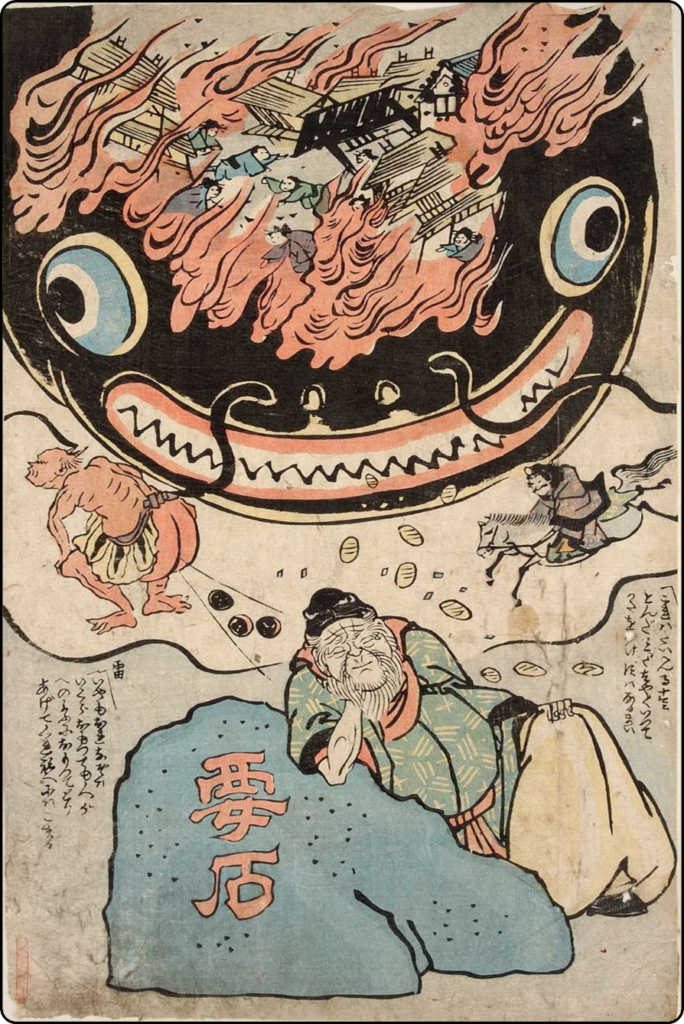
Fig. 3. The Namazu to kaname-ishi (Namazu and the foundation stone) illustration from the 1855 Edo earthquake (Image credit pinktentacle.com).
In the meantime Kashima is riding back to Edo from his meeting with the major Japanese deities in Izumo. Large gold coins falling from the burned Edo, represents the good of redistribution of wealth due to the rebuilding phase after the destruction of the earthquake (Smits, 2006). The falling coins, suggests contrasting thoughts among Edo citizens. Instead of looking at the destruction, many looked at the earthquake as a remedy to the uneven distribution of wealth, sent by the gods to take money from the wealthy merchants and rulers and put it in the hands of ordinary people (Smits, 2006). Many Namazu-e (illustrations of Namazu) illustrated a catfish as a distributor of richness (Fig. 4a) and wealth (Fig. 4b), suggesting that, alongside bringing destruction, he also has a positive effect on the population.

Fig. 4. (a) Illustration entitled Furidashi namazu kusuri (Powdered medicine selling Namazu). (b) illustration entitled Ō-Namazu Edo no furui (The giant namazu and Edo’s prosperity/shaking). Both illustrations from the 1855 Edo earthquake (Image credit pinktentacle.com).
Namazu represented the renewal from which poor and ordinary people have an opportunity to climb up the social classes (Ludwin and Smits, 2007). Figure 4a is an illustration of a whale-like Namazu spouting coins from a blowhole located in the middle of his body, as if he was a steamship. Fisherman on small boats and on the ground try to catch Namazu in order obtain the money (Ludwin and Smits, 2007). Figure 4b illustrates a personified Namazu while selling medicine which is a metaphor of economical wealth distribution. He carries doll-like images of different kind of workers who benefitted from the destruction and rebuilding of Edo, such as carpenters, plasterers, and roof-tile makers (Ludwin and Smits, 2007).
References
Bakun, W.H., 2005. Location and Magnitude of the 1855 Ansei Edo Earthquake. American Geophysical Union, Fall Meeting 2005, abstract id. S21A-0197.
Ludwin, R.S., Smits, G.J., Carver, D., James, K., Jonientz-Trisler, C., McMillan A.D., Losey, R., Dennis, R., Rasmussen, J., De Los Angeles, A., Buerge, D., Thrush, C.P. Clahue, J., Bowechop, J., Wray, J., 2007. Folklore and earthquakes: Native American oral traditions from Cascadia compared with written traditions from Japan. In L. Piccardi, and W.B. Masse (Eds.), Myth and Geology. Geological Society, London, Special Publication 273, 67 – 94. https://doi.org/10.1144/GSL.SP.2007.273.01.0
National Diet Library Great East Japan Earthquake Archive, Earthquake chronological table (Edo period: 1605-1868), https://kn.ndl.go.jp/static/en/edoearthquake.html. Consulted on 11.10.2021.
Smits, G., 2006. Shaking up Japan: Edo society and the 1855 catfish picture prints. Journal of Social History, 1045 – 1078. https://www.jstor.org/stable/3790240
UGSG Earthquake Catalog. https://earthquake.usgs.gov/earthquakes/search/. Consulted on 11.10.2021.
UGSG Natural Hazards FAQ. https://www.usgs.gov/faqs/which-country-has-most-earthquakes?qt-news_science_products=0#qt-news_science_products. Consulted on 11.10.2021.
Ryan, W.B.F., Carbotte, S.M., Coplan, J., O’Hara, S., Melkonian, A., Arko, R., Weissel, R.A., Ferrini, V., Goodwillie, A., Nitsche, F., Bonczkowski, J., Zemsky, R., 2009. Global Multi-Resolution Topography (GMRT) synthesis data set. Geochem. Geophys. Geosyst., 10, Q03014. https://doi.org/10.1029/2008GC002332


